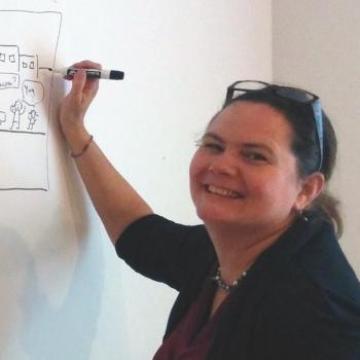AI & Design: Empowering Your Stakeholders with Artificial Intelligence

Overview
How do we design AI systems that augment and empower people? This program connects human-computer interaction (HCI), the multidisciplinary field that focuses on designing interactions between humans and technology, to the transformative effects of AI so that you can better serve your customers and drive your company forward. You'll learn how to use design thinking methods to discover new smart products and apply and adapt the design process for products that integrate artificial intelligence.
Through cutting-edge research and business cases, Stanford faculty and industry experts will help you learn to design better products and processes.
No technical AI or computing skills are required for this executive program.
Get updates on HAI Executive Education opportunities

Key Benefits
Participants will:
- Use design thinking methods to discover innovative products that meet customers’ needs and that are good candidates for AI technologies
- Apply design principles so that AI empower peoples rather than replaces them
- To create user experiences that manage AI's inherent uncertainty and error in your products
- Explore the latest technology and innovation research with Stanford faculty and industry experts
- Visualize what an AI model knows and doesn't know
- Design better products and utilize new forms of user sensing (e.g., voice commands and gestural interaction)
- Consider ethical issues that may arise, and how to mitigate and even avoid them
Who Should Attend
Executives seeking to maximize the benefits of AI in the user experiences of the businesses they lead, unlocking AI’s ability to augment and empower their team members, customers, and stakeholders alike. You have the opportunity to impact your organization’s use of AI technologies and/or user experience, within one (or many) business areas. You recognize the power that AI has to improve the human experience of your organization across stakeholders.
You need to understand the rapidly evolving landscape around AI, human-computer interaction (HCI), and emerging technologies in these critical leadership areas - in a short course format.
- Design leaders in an organization - from any size company or industry - who shape the use of AI within their organizations.
- Key decision-makers and executives seeking a better understanding of the possibilities and challenges around AI’s ability to empower their stakeholders.
- Leaders looking to design their AI and human-computer interaction (HCI) tools to maximize business outcomes.
- Example titles and functions: management consultants, chief design officer, UI/UX design leads; creative directors, UX principal or manager, product design lead; chief technology or chief information officer, chief innovation officer, VP, VC, chief executive officer, board member/ director, other c-suite roles, executive director, director, or senior manager overseeing AI design, user experience design, and/or with key human-computer interaction (HCI) implications.
No technical AI or computing skills are required for this executive program.

Faculty Director
Michael Bernstein : Michael Bernstein, who led the charge for the creation of the Stanford AI for Executives Program, is an Associate Professor of Computer Science and STMicroelectronics Faculty Scholar at Stanford University, where he is a member of the Human-Computer Interaction Group. His research applies a computational lens to helping groups achieve their collective goals. He designs, builds, and studies social computing systems at scales from teams to crowds. This research has won best paper awards at top conferences in human-computer interaction and reported in venues such as The New York Times, New Scientist, Wired, and The Guardian. Michael has been recognized with an NSF CAREER award, Alfred P. Sloan Fellowship, and the Computer History Museum Patrick J. McGovern Tech for Humanity Changemaker Award. Learn more

Additional Faculty
James Landay : James Landay is a Professor of Computer Science and the Anand Rajaraman and Venky Harinarayan Professor in the School of Engineering at Stanford University, specializing in human-computer interaction (HCI). Previously, he was the Laboratory Director of Intel Labs Seattle, a university affiliated research lab that explored the new usage models, applications, and technology for ubiquitous computing. He was also the chief scientist and co-founder of NetRaker, which was acquired by KeyNote Systems in 2004. His current research interests include Technology to Support Behavior Change, Demonstrational Interfaces, Mobile & Ubiquitous Computing, and User Interface Design Tools. Learn more

Maneesh Agrawala: Maneesh Agrawala is the Forest Baskett Professor of Computer Science and Director of the Brown Institute for Media Innovation at Stanford University.. His focus is on investigating how cognitive design principles can be used to improve the effectiveness of audio/visual media. The goals of this work are to discover the design principles and then instantiate them in both interactive and automated design tools. He received an Okawa Foundation Research Grant in 2006, an Alfred P. Sloan Foundation Fellowship and an NSF CAREER Award in 2007, a SIGGRAPH Significant New Researcher Award in 2008, and a MacArthur Foundation Fellowship in 2009. Learn more

Julie Stanford: For the past 19 years, Julie has been the Principal of Sliced Bread Design, a user experience design agency that has successfully launched products for 60+ clients and counting. She specializes in rigorously applying the design thinking process to help clients redefine the problem they are solving and design the right solution. From needfinding and ideation to prototyping, user testing, and rapid experimentation, she has developed a design toolbox that's successful for creating modern apps that solve modern problems. Learn more

Christina R Wodtke: Christina Wodtke is an author, speaker, and lecturer at Stanford University with insight into human innovation and high-performing teams. Her resume includes re-design and initial product offerings with LinkedIn, MySpace, Zynga, Yahoo! and others, as well as founding three startups, an online design magazine called Boxes and Arrows, and co-founding the Information Architecture Institute.Her bestselling book, Radical Focus, tackles the OKR movement and startup culture with an eye to getting the right things done. Her other books include The Team that Managed Itself, Information Architecture: Blueprints for the Web and Pencil Me In (on visual thinking for the workplace.) Learn more